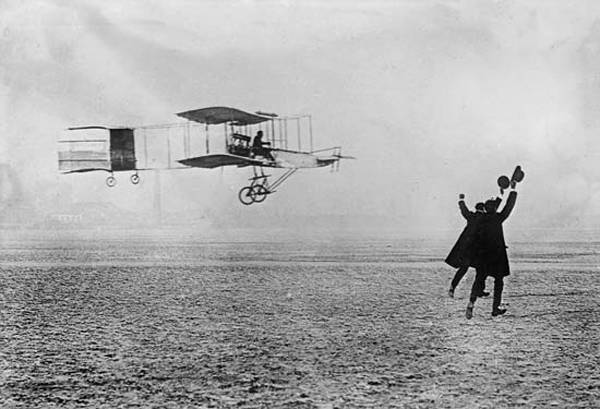In the early 1870’s, the United Brethren Churches held their annual convention on the campus of Hartsville College in Hartsville, Indiana. One year the college president opened the conference by commenting, “We live in an exciting age, the age of inventions.” A United Brethren Bishop, who wanted to know what kinds of inventions, interrupted him. The college president replied, “Why for example, I believe that one day we will be able to fly through the air like birds.” The Bishop responded, “That is heresy, absolute heresy, the Bible says that flight is reserved for the angels. We will have no such talk at this conference.” At the end of the conference, Bishop Milton Wright returned home to his wife and two young sons in Dayton, Ohio.
Wilbur Wright was born in Millville, Indiana in 1867, the second son of Milton and Susan Wright. Four years later his brother Orville was born in Dayton, Ohio. The Wright home was one of strict discipline, but the children were encouraged to investigate whatever aroused their intellectual curiosity. In 1878, Bishop Wright bought the boys, ages eleven and seven, a fluttering helicopter-like toy made of cork with a propeller driven by a rubber band. They played with the toy, and later when it broke, they built one themselves. This toy sparked Wilbur and Orville’s lifelong fascination in flying.
Both boys attended high school, but neither of them graduated. In 1889, the brothers designed and built a small printing press and began publishing a weekly, and later a daily newspaper. In 1892, capitalizing on the national bicycle craze, they opened a small bicycle repair shop in Dayton. Four years later, the brothers began building their own bicycle, which they called the Wright Flyer.
In 1896, their interest in flying and designing flying machines was rekindled due to several events. Chicago aviation pioneer, Octave Chanute, successfully tested gliders on the shores of Lake Michigan, and German aviation pioneer, Otto Lilienthal, successfully flew in a glider. These feats made the brothers believe flight was possible, and the fact that Lilienthal was killed did not dampen their enthusiasm. They began to read every article they could find about aviation. They also contacted the National Weather Service, which recommended Kitty Hawk, North Carolina, as an ideal location for testing gliders, due to its prevailing winds and open beaches.
In 1900, the brothers used proceeds from their bicycle sales and traveled by train to Kitty Hawk. They began by flying large double-winged kites and then progressed to unmanned gliders. In the summer of 1901, they built gliders with larger wingspans and made dozens of short manned glider flights traveling distances up to 400 feet. Their success wetted their appetite to build a powered flying machine. In 1903, the brothers built the powered Wright Flyer I out of spruce wood, special fabric for the wings, and a specially-designed wooden propeller they copied from a boat motor.
Despite their repeated failures, and the fact that what they were trying to do was considered impossible, the two bicycle mechanics believed in themselves. They were so sure of their success, they had hired a photographer to take a picture when their heavier-than-air flying machine lifted off the rails for the first time on the morning of December 17, 1903. Orville flew 120 feet, in twelve seconds. Later that day, Wilbur flew for 59 seconds. On the same day they sent a telegram to their father and sister, Katherine, in Dayton. It read, “Success. Four flights today. First flight 12 seconds. Longest 59 seconds. Home for Christmas.” Katherine put the message in the Dayton newspaper, and although her brothers had just revolutionized travel on planet earth, the local headlines read, “Popular local bicycle mechanics will be home for the holidays.” People are always underestimating what is possible.
In the following years, the brothers continued to perfect their “flying machine,” and on May 25, 1910, their 81-year-old father accompanied them to an airfield eight miles outside of Dayton. The brothers wanted to demonstrate their latest design: an airplane with wheels – no longer would they rely on a wooden rail to launch their planes. Although he had long-since reconsidered his earlier position that flight was reserved for angels, and had become very supportive of his sons’ efforts, Milton Wright had never expressed a personal interest in flying. Late in the afternoon, Orville took Milton for his first flight. For seven minutes, they flew at an altitude of 350 feet. Worried about his father’s reaction, Orville was thrilled when Milton leaned close to his ear and shouted over the engine noise, “Higher, Orville, higher!”
“I have learned to use the word impossible with the greatest of caution.” Werner Von Braun
